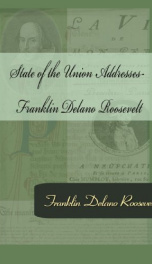State of the Union Address

The State of the Union Addresses of Franklin Delano Roosevelt on January 3, 1934; January 7, 1943; January 11, 1944; January 6, 1945; January 4, 1935; January 3, 1936; January 6, 1937; January 3, 1938; January 4, 1939; January 3, 1940; January 6, 1941; January 6, 1942.Franklin Delano Roosevelt (January 30, 1882 – April 12, 1945), often referred to by his initials FDR, was the 32nd President of the United States. He was a central figure of the 20th century during a time of worldwide economic crisis and world war. Elected to four terms in office, he served from 1933 to 1945 and is the only U.S. president to have served more than two terms. Roosevelt has been consistently ranked as one of the greatest U.S. presidents in historical rankings, alongside Abraham Lincoln and George Washington. A 1999 survey by C-SPAN found that by a wide margin academic historians consider Abraham Lincoln, George Washington and Roosevelt the three greatest presidents, consistent with other surveys. Roosevelt is the sixth most admired person from the 20th century by US citizens, according to Gallup. Both during and after his terms, critics of Roosevelt questioned not only his policies and positions, but also the consolidation of power that occurred because of his lengthy tenure as president, his service during two major crises, and his enormous popularity. The rapid expansion of government programs that occurred during Roosevelt's term redefined the role of the government in the United States, and Roosevelt's advocacy of government social programs was instrumental in redefining liberalism for coming generations. Roosevelt firmly established the United States' leadership role on the world stage, with pronouncements such as his Four Freedoms speech, forming a basis for the active role of the United States in the war and beyond. - Wikipedia
Info about the book
Author:
Series:
Unknown
ISBN:
1406934208
Rating:
4/5 (4)Your rating:
0/5
Languge:
English
Users who have this book
Users who want this book
What readers are saying
What do you think? Write your own comment on this book!
write a commentif you like State of the Union Address try:
Other books by this author
Do you want to exchange books? It’s EASY!
Get registered and find other users who want to give their favourite books to good hands!


